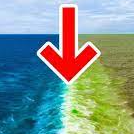Why the Atlantic and Pacific Oceans Don't Mix

About
Scientifically explained
Description
At the point when you take a gander at the oceans and seas on the guide you may believe that they simply stream into one another. It appears as though there's just a single enormous sea, and individuals just gave various names to its parts. Indeed, you'll be flabbergasted at how striking the lines between them are!
The line between the Pacific and Atlantic seas resembles a line between 2 universes. Maybe the two seas meet at an undetectable divider which doesn't allow them to stream into one another and blend their waters. Why in the world does it occur? We know without a doubt there is no imperceptible divider inside, and water will be water. So what could meddle with its blending?
- Pacific seas have diverse thickness and compound make-up, the degree of saltiness and different characteristics. One can see by their shading that they are a long way from being something similar.
- Haloclines – borders between waters with various saltiness – are the most fabulous, and this is the thing that we see when the Atlantic and the Pacific seas meet.
- Haloclines seem when water in one sea or ocean is something like multiple times saltier than in the other.
- Another significant contrast between the two seas' water is the strength of particles' association, or surface elasticity.
- Maybe they could steadily begin blending in with time, however as the streams in them have inverse bearings, they simply don't have the opportunity to do this.
- There are likewise thermoclines – borders between water of various temperatures, similar to the warm water of Gulf Stream and a lot colder North Atlantic Ocean.
- The North and Baltic Seas meet close to the Danish city of Skagen. The water in them doesn't blend in light of various thickness.
- The Mediterranean Sea and the Atlantic Ocean meet at the Strait of Gibraltar and have an alternate thickness and saltiness, so their water doesn't blend as well.
- The Uruguay River and its afflux meet in Misiones region in Argentina. One of them is cleaned to be utilized in horticulture, and different gets practically red on account of soil during blustery seasons.
- Mosel and Rhein meet in Koblenz, Germany. Rheine has lighter water and Mosel – hazier.
- Alaknanda and Bhagirathi Rivers meet in India. Alaknanda is dim and Bhagirathi is light.
- The Jialing and Yangtze Rivers meet in Chongqing, China.
The Jialing is spotless and the Yangtze is brown.
- The water of the Chuya has a surprising overcast white tone here and looks thick and thick. Katun is perfect and turquoise. Streaming into one another they structure a solitary two-shaded stream that doesn't blend for
About
Scientifically explained
Description
At the point when you take a gander at the oceans and seas on the guide you may believe that they simply stream into one another. It appears as though there's just a single enormous sea, and individuals just gave various names to its parts. Indeed, you'll be flabbergasted at how striking the lines between them are!
The line between the Pacific and Atlantic seas resembles a line between 2 universes. Maybe the two seas meet at an undetectable divider which doesn't allow them to stream into one another and blend their waters. Why in the world does it occur? We know without a doubt there is no imperceptible divider inside, and water will be water. So what could meddle with its blending?
- Pacific seas have diverse thickness and compound make-up, the degree of saltiness and different characteristics. One can see by their shading that they are a long way from being something similar.
- Haloclines – borders between waters with various saltiness – are the most fabulous, and this is the thing that we see when the Atlantic and the Pacific seas meet.
- Haloclines seem when water in one sea or ocean is something like multiple times saltier than in the other.
- Another significant contrast between the two seas' water is the strength of particles' association, or surface elasticity.
- Maybe they could steadily begin blending in with time, however as the streams in them have inverse bearings, they simply don't have the opportunity to do this.
- There are likewise thermoclines – borders between water of various temperatures, similar to the warm water of Gulf Stream and a lot colder North Atlantic Ocean.
- The North and Baltic Seas meet close to the Danish city of Skagen. The water in them doesn't blend in light of various thickness.
- The Mediterranean Sea and the Atlantic Ocean meet at the Strait of Gibraltar and have an alternate thickness and saltiness, so their water doesn't blend as well.
- The Uruguay River and its afflux meet in Misiones region in Argentina. One of them is cleaned to be utilized in horticulture, and different gets practically red on account of soil during blustery seasons.
- Mosel and Rhein meet in Koblenz, Germany. Rheine has lighter water and Mosel – hazier.
- Alaknanda and Bhagirathi Rivers meet in India. Alaknanda is dim and Bhagirathi is light.
- The Jialing and Yangtze Rivers meet in Chongqing, China.
The Jialing is spotless and the Yangtze is brown.
- The water of the Chuya has a surprising overcast white tone here and looks thick and thick. Katun is perfect and turquoise. Streaming into one another they structure a solitary two-shaded stream that doesn't blend for

